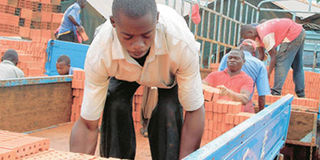Uganda Clays: How it fell into debts

A man off loads roofing products manufactured by UCL. File photo
Uganda Clays was once a beacon, enjoying a near monopoly in the manufacture of clay products.
Its status, however, begun to dip in 2009 and now UCL finds itself in deep indebtedness.
Majority shareholder National Social Security Fund is placing itself as the saviour in a deal likely to be completed by June 2015.
At the 2014 UCL annual general meeting, Geraldine Ssali, the then acting NSSF managing director told shareholders the sustainability of these loans had come into question, saying: “It [UCL] is going to run insolvent if we ask them to pay the debt.”
The negotiations are still ongoing but if completed, NSSF’s stake will rise to 66 per cent from 35 per cent and is likely to increase its representation on the board to six - at least three quarters of the board.
On NSSF’s books, UCL’s loan has been written off [loss].
In 2009, John Wafula, who has since died, took journalists on a guided tour of a Shs39b factory in Kamonkoli, Budaka District.
Wafula, the then UCL managing director said the factory would transform its fortunes. However, he did not live to see this as a year later he left the company and died in 2011.
At the time, shareholders were told Kamonkoli was part of the expansion plan that would serve the rapidly growing demand for construction materials.
The Kenyan exit
UCL was the first company to list on the Uganda Securities Exchange in 2000, registering tremendous successes at the stock for a number of years. However, things started falling apart when Kenya Clay Products Limited (KCPL) exited the company as a major shareholder.
“KCPL’s departure in 2006 left the UCL with no shareholder and board member who understood the dynamics of the construction sector in Uganda,” says a retired staff who spoke on condition of anonymity.
The departure of the Kenyans was also during a period when discussions to expand were ongoing. This would be an option to expand the Kajansi factory built in the 1950’s when UCL was founded.
The board and shareholders approved the expansion to construct the factory including financing options from commercial banks and a rights issue. A rights issue is where shareholders buy more shares at a discount. The location would be Kamonkoli in eastern Uganda where clay deposits had been found.
Kamonkoli delays and fines galore
The shareholders heeded and through the rights issue, Shs10b was raised but that was only a fraction of the Shs39b needed to complete the project.
The company sought for more financing from Standard Chartered and East African Development Bank at an interest of 19 per cent with a five year recovery.
That was in 2007 and by end of 2008; the plant had not yet been completed with the then managers blaming “the post-election violence in Kenya” as the major delay for importation of required machinery.
“The bankers could not wait. The company had started defaulting on payments and fines had to be incurred,” the retired staff, who was with UCL for a decade says.
Eventually in the second half of 2009, Kamonkoli was commissioned by President Museveni but UCL posted a Shs707m loss in the same year with their debt obligation rising to Shs12b.
The situation worsened in 2010 as losses escalated to Shs3.8b and this was not helped by the bankers who started showing signs of stress over concerns that Kamonkoli would not deliver required income to meet due payments.
From the time it had become operational in 2009, management needed additional capital injection which was given by NSSF as a bailout. Around the same time, Wafula exited the company and was replaced by Charles Rubaijaniza, who in 2011 was elevated from chief financial officer.
Perspective
Several sources we talked to including members of senior management who left the company indicate the troubles started after members disagreed on the location of the new factory.
In fact they blame part for the departure of KCPL as it opposed the Kamonkoli location.
They say tapping the Kenyan market wasn’t realistic as there was a plant in Kisumu supplying products at a much lower price. To-date UCL’s biggest market out of Uganda is South Sudan.
It should be noted that among the proposed locations for the plant was Pakwach in northern Uganda. NSSF had two seats on the board then but did not veto the decision and they now will not accept a haircut on the loan extended to UCL.
The bail out
To avoid further penalties from the bankers, NSSF offered a loan of Shs11b at 15 per cent per annum, which was approved by Richard Byarugaba.
Notably, Shs3b of that money was meant to improve a kiln at the Kamonkoli factory.
In 2011, the company posted a net profit of Shs600m but other costs cutting measures including cutting of staff were taken. However, expected returns from Kamonkoli were not realised with the section posting a loss of Shs2b.
In the same year, competition in the form of Lweza Clays and other roofings manufacturers has taken advantage of Uganda Clays’ troubles to eat into its market share. Rubaijaniza, who had steered the company in two years of profitability left as continued losses posted at Kamonkoli seemed to have been stressing the company’s financials.
The plant in 2013 posted another loss of Shs1.5b and was blamed on the inefficiency of the furnace oil used at the factory, which has since been reviewing and replaced with coffee husks. Currently, George Inholo, who was hired from Unilever carries the responsibility of reviving the company’s fortunes.




